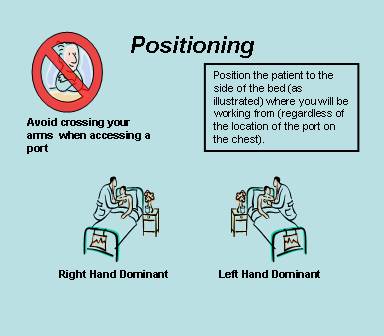| Port Access Course: Non-Coring Needles and Accessing |
|
| Developed by Teresa Heithaus MSN, RN |
A Division of the Staff Development Department |
| |
|
|

|
|
Non-coring Needles vs. Standard beveled needles
When accessing implantable ports, a non-coring needle must be used. Non-coring needles are designed with a 45º angle at tip of the needle. This is done to reduce the likelihood of shearing the septum during insertion. The design of a standard beveled needle can damage the septum due to the shearing effect it would have upon insertion. Standard beveled needles should never be used for accessing a port.

Portal Needle Clearance
Portal needle clearance is described as "a measure of the distance between the bottom of the portal septum and the reservoir floor as it compares to the height of the bevel of various gauges of non-coring needles (Deltec Inc., 2004, para 1)". In other words, it is important to consider the gauge size and how long the needle is in relationship to the port that is going to be accessed. Needles that are short in length, entering a high profile port may not fully clear the septum. This will have an impact on the delivery of IV fluids. Extravasation has been associated with the introduction of needles that do not clear or barely clear the septum. In general, you will be making an estimate of the type of port that you are about to access on the basis of palpation and visual observation. Therefore you will consider carefully the length and gauge of needle you are using. CLICK HERE for more information and pictures of needle clearance.
Needle Gauge
The rule that applies to gauge size selection with peripheral IVs is the same for port access needles. In general you should always choose the smallest gauge size that will suit the purpose of the IV fluids that you will be infusing. If the patient required the infusion of blood products, a larger gauge needle will be required (Weller, 2004).
Needle Length
When considering a needle length for accessing implantable ports, it is better to over-estimate than to under-estimate the length. As previously mentioned, shorter needles that barely clear the septum are associated with extravasations. Shorter needles are also more likely to displace due to body movement. Below is a needle selection reference chart that will provide you with general guidelines for choosing an appropriate needle length when accessing and is not intended as your only resource.

Non-coring needle features
CLICK HERE for a short video on the standard non-coring needle features of the "Gripper". This is the needle that is used hospital-wide for standard port accessing.
CLICK HERE for a short video on the power non-coring needle features of the "Power LOC". This needle is only available in interventional radiology for use with power injectors. Should you receive a patient with this needle in place, the needle will serve as your access for 7 days from time of being placed in the patient.
Accessing
When preparing to access a patient, prepare the patient by:
Explaining the procedure
Preparing and clearing the work surface
Position the patient so that YOU are in a comfortable position accessing hand closest to the patient
 CLICK HERE for information on how to access an implantable port.
CLICK HERE for information on how to access an implantable port.
CLICK HERE for information on how to remove a non-coring needle
Take the optional skillbuilder then click on the final link of the program, "Maintenance and Care" which is located below under "Useful Links"
|
|
|
|
| My Quia activities and quizzes |
|
https://www.quia.com/jg/1339959.html |
|
|
|
|
| Last updated 2016/07/08 12:40:36 EDT | Hits 15922 |
|
|